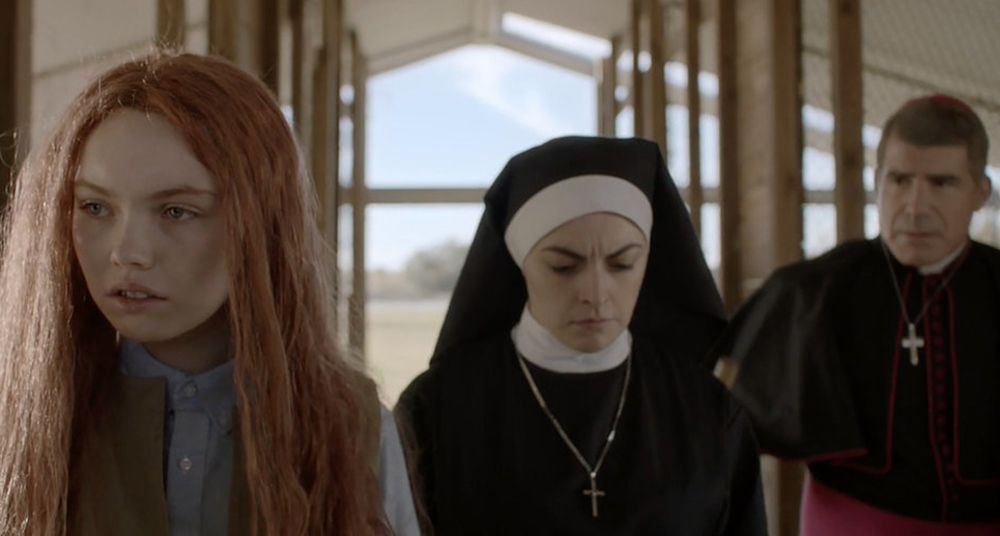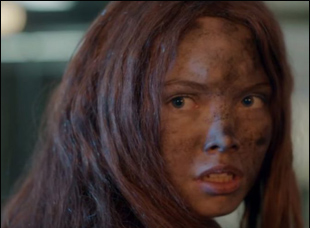It would certainly be easy to understand if Pollyanna McIntosh wouldn’t have wanted to return to the world of “The Woman,” a role she played twice in adaptations of Jack Ketchum’s novels “Offspring” and “The Woman,” tracking a feral female taken in by a supposedly civilized lawyer who gradually reveals himself to be more barbaric than she ever could be, particularly when applying their own ideas of domestication to her. The actress had to spend hours in makeup to appear as if she’d just come in from the wild and then put through the paces of an emotionally and physically taxing performance. But while such demands might’ve felt confining for others, McIntosh could only feel liberation.
“It’s a challenging thing to take up, but a joy,” says McIntosh, who returns for a third time with “Darlin’”. “Stepping under her dirty skin or in her bare feet — there’s no shoes involved — is honestly very freeing, especially when you’re directing yourself.”
Yes, McIntosh makes her feature directorial debut with “Darlin’”, the first in “The Woman” series that isn’t a direct adaptation of one of Ketchum’s books and after investing herself fully in the character for two films, she is able to channel the Woman’s restless energy into a vigorous thriller that passes the baton to some degree to the daughter named Darlin’ that led the Woman into civilization to protect her in the last chapter. Then a baby, Darlin’ (Lauryn Canny) has hit her teen years in the film that takes her name, given temporary shelter by concerned hospital staff who keep an eye out for something more permanent. But a kindly nurse (Cooper Andrews) doesn’t know what he’s setting up Darlin’ for when he takes her to St. Philomena’s Group Home for Girls, run by an authoritarian man of the cloth known only as the Bishop (Bryan Batt) who treats all of the young women under his care as if they were animals to be tamed, but seems to hold special contempt for his newest charge.
The imposition of arbitrary rules on the women — and cruel punishment, if not observed — expose a different god the Bishop is beholden to than the one he thinks he does, and McIntosh shrewdly uses Darlin’s crafty navigation of the patriarchal system, adhering to the laws of the wild rather than of polite society, to expose the misogyny inherent in social conditioning. (It’s no surprise that McIntosh recently told Eye for Film’s Jennie Kermode that one of her favorite scenes in “Darlin’” is one in which the girls work out the solution to a snake attack when left to their own devices, simply talking it through with no reference.) Still, as chilling as the film is in outlining inequity at the heart of the culture, McIntosh delivers the horror viscerally as well with Darlin’ retaining her mother’s lust for blood.
Naturally, there is plenty of the red stuff both spurting out and running through McIntosh’s vibrant and worthy extension of the Ketchum series and on the occasion of the film’s release in theaters and on VOD this week after making a splash at SXSW earlier this year, the writer/director spoke about seizing the opportunity to take the director’s chair, work with her lead actress on a variation on the role she originated herself and the time she nearly got arrested during filming.
I was shooting “Hap and Leonard” in Louisiana and I got a call from Andrew [van der Houten], who produced “The Woman” and “Offspring” and he said, “We’re ready to do the sequel.” And I knew the fans had been asking about it for ages, so I was like “Okay, cool.” And then he said, “Would you like to direct it?” It was a shock, and of course, I was thrilled with the idea, but “The Woman” is a film I respect so much and when I first heard about it, I was like, “How the fuck is this going to work?” Because the Woman is so quiet and we need to bring her into a new scenario, so I asked, “Who is going to be writing it?” And he said, “Well, we’re going to be looking at different writers” and I said, “Well, can I write it?” Because then I can live with it for two years and I knew I’d make it into something I wanted to do. And [Andrew] went off and thought about it, conversed with Lucky and came back and said, “Yeah.”
I really wanted to focus on Darlin’ because I was fascinated by the idea of a young teenager coming out of the woods in real time from “The Woman.” Like how would life be like for her now, having been there for eight years [since the events of] “The Woman” and having been through that crazy abusive childhood that she was already in. It was also a loving family in some ways, so there was so much complexity there to explore. But again, the challenge was how do you write a standalone sequel that people can enjoy if they haven’t seen “The Woman” or “Offspring.”
Was there something that cracked it for you?
Coming up with homeless women she could live amongst just made sense to me because I was really struggling with how she could be in the city, have a solid story and connect with somebody somewhere without it just being insanity or goofy, especially for newcomers to the story, so I just figured if you’re homeless and you’re not getting to clean as much anyway, there might be mental health issues in that community and they might be accepting of a silent person who looks filthy.
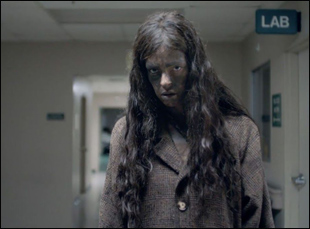
Well, of course. The seed of the idea was researching feral children and finding there were two girls in India who a Western priest had claimed he had found in the wild and in fact, they were two girls with special needs who had just been mistreated by their family, and he knew this and was lying about it. So it was my wondering about what he would gain from that and why he would tell that lie that brought me to the seed of the idea of Darlin’ and the Bishop.
The power dynamics manifest themselves visually into what may be my favorite scene of the film where you have the Bishop and his subordinate Sister Jennifer, played by Nora-Jane Noone, talking and behind him is an entirely red wall and below her feet, it’s an entirely red floor, so there’s almost this psychedelic feeling you get when you cut from one side to the other. How did that come about?
That’s so nice to hear because I remember horror films from a very young age that were terrifying to me that were made in the ‘50s to ‘60s because it was so bright in the color, and I don’t remember what movie it was, but [in one film] there was this red room and there was this cardinal in it, all in red and it scared the bejeezus out of me, so I very much wanted the Bishop’s office to be red. The art department on this was incredible and it really is a room in a church we found and they let us paint it red. And build a confessional inside the office as well.
Is it true you were shooting under some pretty inclement conditions in Louisiana?
We did kind of have to jump around and it was the art department that had it the toughest because they had to speed up on certain sets and abandon other ones to move on to the next thing to ensure we had the right thing for the day. We lost a day to snow and we lost four days off our schedule about a week before we started shooting – it was a kooky shoot, but it’s always like that on an independent shoot these days, so you better be ready to move fast and find solutions quickly.
The snow ended up serving us amazingly well because I went to sleep thinking of a 12’ by 25’ rectangle of fake snow for the Woman and Darlin’ to walk across [in the opening scenes of the film] and that was really all that you were going to see with the ski pole. Then I woke up to a winter wonderland and although we couldn’t get most of the cast we were going to shoot with that day to the sets we needed them on because of driving conditions – it was too dangerous – we still had some people on location and we could go into the woods and we could shoot that amazing snow opening, which was just so cool. But the weather was very changeable and it takes a friggin’ village. We did it somehow.
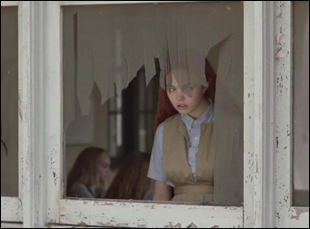
I really feel like everything absolutely was the way it was in the script, but I can’t stop thinking about Cooper [Andrews] and I in that car scene and being pulled over by the cops because we lost our hired cop who was following us. We ended up driving into a real cop’s purview and he was not amused, especially when we had no driver’s license and I was dressed [like the Woman, looking feral] and you know, Cooper’s a big guy.
But something unexpected in the film? Honestly, I think it was watching my brain come out on film. It was crazy because Halyna Hutchins, the DP, and I worked so closely together and and we were right on it about the light and the color and exactly the look that was right for the film. It was just like seeing my brain spill over. [laughs] It was weird.
I was thinking during that car chase, it might’ve been difficult to maintain a performance while directing. Was it a challenge?
Yeah, I made a 35-minute short before called “Perfect” in which I played the lead and I was in almost every frame, so I already had the experience and knew I was ready to do it in a feature, but I didn’t want to be the lead of this film. I wanted to go somewhere else with it. I wanted to explore it through someone else’s eyes, so at first when I was writing it, the only note I really got was put more of the Woman in because I put her too much on the fringes. But I really love her, so it’s a really pleasurable thing to bring her back and play her again, and just to have so much control over how she’s going to dress and what her story’s going to be.
How much did you want to impart what you might’ve learned to play the Woman the first time around versus letting Lauryn to discover a performance on her own?
I always hope that I’ll work this way, which is you go back and forth with the actor and you figure out how they work best. And she luckily happened to be a very curious person, and she said, “Please give me everything. Tell me everything you did.” So I could do that, but I did stop myself at one point – had a little chat with myself, because I love this girl so much and we’re dear friends now, and I said, “Make sure you don’t mother too much” because she’s got to be independent in this. I know she’s got it already in her and we just got along famously.
When she came into the building for the audition, I was waiting there alone – she was the first person in after me and she was so earthy and so funny and so clearly gave a shit about story and her work whilst also being really [being into] gallows humor and Celtic and a wild thing. I thought I hope she’s as great as she is as an actor as she is as a person because I knew I could collaborate well with her as a person and sure enough, she absolutely brought it in the room. She’ll tell you I helped with all this research and whatnot, but when she was in the room, she was ready to play the role and any moment she had questions or wasn’t sure about something, we got very deep very quickly and very easy communication.
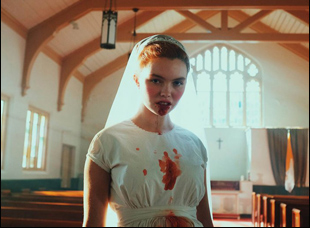
It’s been amazing because there’s nothing like watching a film with an audience and to feel their laughter, their shock, their enjoyment of the scares and hearing the questions afterwards and [feeling] the heart that they’ve taken from the film that I had hoped that they would. It’s been incredibly gratifying and it’s quite a vulnerable thing bringing out your first film, more so when I feel quite protective of everybody’s work on it because I know how hard they worked. Of course, there are people who don’t like it, and that’s to be expected, but I’ve been very bowled over by how many people who’ve really, really truly got it.
Especially quite famously when “The Woman” faced such a crazy reaction when it first premiered at Sundance. Was that ever something you might’ve been intimidated by?
Well, I’ll never forget Lucky’s face when that started happening. He was horrified, but that angry guy helped us in the end because we got so much more coverage because of what happened, which is very useful at a festival like Sundance where there’s so many great films. But I wasn’t [intimidated] actually. I knew one of the reasons Andrew was asking me to helm it was probably because having a female in charge of it was a good idea at this point because of some of that shock from “The Woman,” and not that I think that was necessary, but I just was ready to step up to the challenge and to do it. Even now, I’m getting interview questions like, “How do you think the Catholic Church is going to respond to that element in the film?” And stand by what it represents…
It’s hardly as if they haven’t been exposed as far worse when it comes to the issues this film raises.
That’s the other thing. It’s like I’m not damning faith or even religion, but abuse of power is ripe for damnation, especially right now, and I’ll yell it from the rooftops as loud as I can.
“Darlin'” opens on July 12th in Los Angeles at the Laemmle Music Hall and in Brooklyn at the Nitehawk Cinema Williamsburg. It will also have a special screening at Fantasia Fest in Montreal on July 15th and is now available on iTunes.




